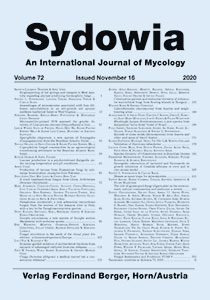
Production of laccase from filamentous fungi by submerge fermentation, examples from Pakistan Aisha Umar Sydowia 72: 65-76 Published online on February 4th, 2020 Biosynthesis of laccase from filamentous fungi is a renowned achievement in the research community. Maximum production of laccase at low cost can be reached by utilizing the submerge fermentation technique. Different filamentous fungi were isolated from various environmental sources and identified by ITS. Maximum laccase enriched fungal species were selected by adding guaiacol (0.02 %) in the nutrient agar plate media. Laccase activity was also evaluated in flask media. Highly active extracellular laccase (U/ml) was yielded by Aspergillus flavus and Penicillium pasqualens. These two species showed strongest oxidation of guaiacol amongst all tested filamentous fungi. Many reddish brown colored zones were made by filamentous fungi around their mycelium on solid agar plate media, whereas in shake flask, maximum laccase was released by those species, which showed minimum oxidative zones on agar plate media. Keywords: Guaiacol, laccase, polymerization, oxidation, DNA. |
 |